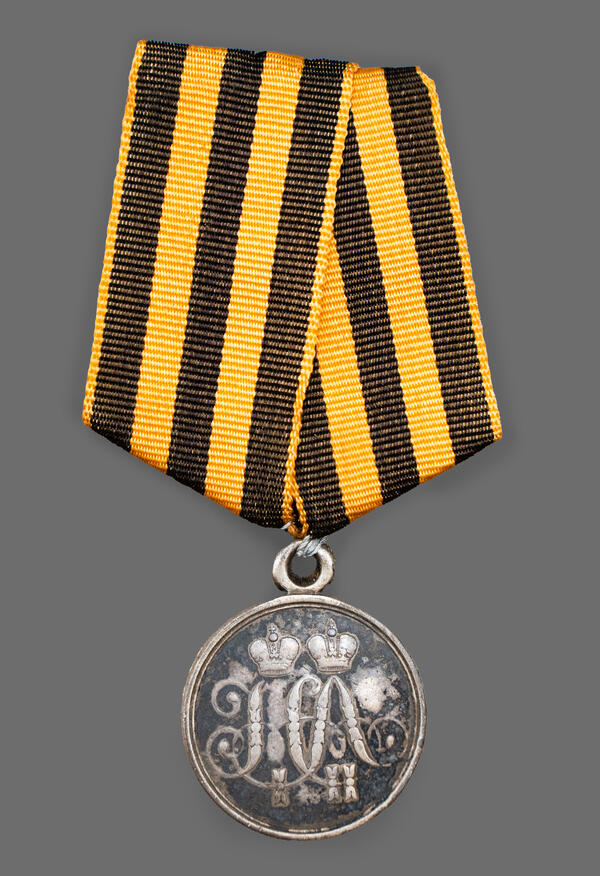The commemorative bronze medal is dedicated to the completion of St. Isaac’s Cathedral in St. Petersburg, one of the most famous architectural structures in Russia.
On the obverse of the medal, in the center, there is a medallion with a chest-length portrait of Emperor Peter I with a laurel wreath on his head. There are five more medallions around it, separated from each other by laurel, oak branches, and stars. They depict portraits of Catherine II, Paul I, Alexander I, Alexander II, and Nicholas I.
The south facade of St. Isaac’s Cathedral is depicted on the reverse of the medal, and the inscription in a circle: “Give to Caesar what is Caesar”s and to God what is God”s. The reconstruction of the Cathedral began under Alexander I”rule and continued under Nicholas I”. Below, under the edge, there is another embossed inscription: “Reconstruction was ended in the reign of the Sovereign Alexander II. The Cathedral was consecrated in the name of St. Isaac of Dalmatia on May 30, 1858.”
Portrait medalist Alexander Lyalin made the front side of the medal, and Vasily Alexeyev made the reverse side according to Lyalin’s sketch.
The first St. Isaac’s Church in St. Petersburg was laid in 1709. Peter I was married to Catherine there. However, a few years later the church was dismantled. A new one, also dedicated to St. Isaac, was laid in 1717. During the reign of Anna Ioannovna, it was seriously damaged by fire and a few years later began to deteriorate. In 1768, the foundation of the church began being built at the new place, which was consecrated in 1802. However, the architecture of this building proved unsuccessful, so the architect Auguste Montferran was commissioned to design a new cathedral. Erection works began in 1818. The architect managed to preserve all three of the then existing consecrated altars.
The construction of the cathedral lasted for 40 years. The cathedral was solemnly consecrated only in 1858: the high altar was consecrated on May 30, the day of St. Isaac of Dalmatia, and the side-altars — on June 1 and June 8. Huge crowds filled the temple, the square next to it, neighboring streets, and even the roofs of nearby houses on those days. Troops in full ceremonial uniform lined up around the cathedral. The clergy of all St. Petersburg churches in white and gold garments participated in a procession from St. Isaac’s Cathedral to Kazan Cathedral and back.
Emperor Alexander II, grand duchesses, grand dukes, and the entire court marched to the cathedral in a festive cortege. The ceremony on May 30 began at 9 am and ended at about 4 pm. St. Isaac’s Cathedral was proclaimed the cathedral of the Russian Orthodox Church and remained so until 1922.
On the obverse of the medal, in the center, there is a medallion with a chest-length portrait of Emperor Peter I with a laurel wreath on his head. There are five more medallions around it, separated from each other by laurel, oak branches, and stars. They depict portraits of Catherine II, Paul I, Alexander I, Alexander II, and Nicholas I.
The south facade of St. Isaac’s Cathedral is depicted on the reverse of the medal, and the inscription in a circle: “Give to Caesar what is Caesar”s and to God what is God”s. The reconstruction of the Cathedral began under Alexander I”rule and continued under Nicholas I”. Below, under the edge, there is another embossed inscription: “Reconstruction was ended in the reign of the Sovereign Alexander II. The Cathedral was consecrated in the name of St. Isaac of Dalmatia on May 30, 1858.”
Portrait medalist Alexander Lyalin made the front side of the medal, and Vasily Alexeyev made the reverse side according to Lyalin’s sketch.
The first St. Isaac’s Church in St. Petersburg was laid in 1709. Peter I was married to Catherine there. However, a few years later the church was dismantled. A new one, also dedicated to St. Isaac, was laid in 1717. During the reign of Anna Ioannovna, it was seriously damaged by fire and a few years later began to deteriorate. In 1768, the foundation of the church began being built at the new place, which was consecrated in 1802. However, the architecture of this building proved unsuccessful, so the architect Auguste Montferran was commissioned to design a new cathedral. Erection works began in 1818. The architect managed to preserve all three of the then existing consecrated altars.
The construction of the cathedral lasted for 40 years. The cathedral was solemnly consecrated only in 1858: the high altar was consecrated on May 30, the day of St. Isaac of Dalmatia, and the side-altars — on June 1 and June 8. Huge crowds filled the temple, the square next to it, neighboring streets, and even the roofs of nearby houses on those days. Troops in full ceremonial uniform lined up around the cathedral. The clergy of all St. Petersburg churches in white and gold garments participated in a procession from St. Isaac’s Cathedral to Kazan Cathedral and back.
Emperor Alexander II, grand duchesses, grand dukes, and the entire court marched to the cathedral in a festive cortege. The ceremony on May 30 began at 9 am and ended at about 4 pm. St. Isaac’s Cathedral was proclaimed the cathedral of the Russian Orthodox Church and remained so until 1922.








